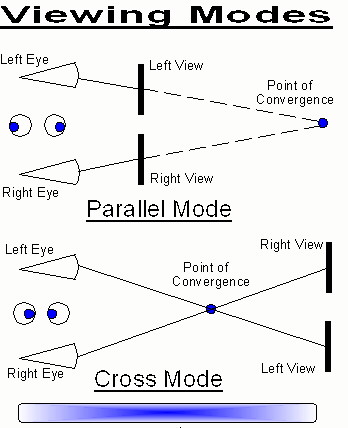Help With Viewing
Stereo Images
There are two modes for viewing these stereo
images, cross and parallel. Most people find one easier than the
other, so you should experiment with both to find out which comes more
naturally for you. In the long run cross view is more versatile (the
image separation can exceed the separation of your eyes without causing
difficulty), but either works well for small images.
The basic idea is that you must get one eye to
look at one of the image pair, the other eye at the other. Slight differences
in the pictures provide clues which your brain interprets as depth information
to create the sense of range. To do this 'split imaging' you either
look beyond the pictures (as in the popular stereograms that look like
a jumble of colors until you look beyond them), or look in front of the
image pair (cross your eyes). The idea is illustrated in the following
drawing.

When you first start trying to split the view
you should see a partial 'phantom' image(s) appear between the two real
images. Keep your attention on this phantom image(s). Try to change
the distance you are looking at so the phantom image(s) becomes wider.
If you see two phantom images try to align some prominent feature in them
more closely. At some point, when the phantom image is nearly as
wide as a real one (or the two phantoms are more nearly aligned), the stereo will
'jump' into view, and you will see three complete images with the middle
one in stereo. The depth illusion is quite strong, so you won't have
any doubt when you've got it right. After some practice the jump
comes much more readily, and you feel much more comfortable.
For skill development you may use the 'Practice
Views' below in which image pairs are graded in size. Start by getting
the small images (1) at the upper left into stereo, then simply drop your
gaze to the next row (2, 3, 4, etc). Once a bit of skill is acquired
you may start at the upper right (3), and continue with even larger images
in the right column (8, 9, etc). You may also start with higher numbered
images, once you have some control and know what you're trying to do.
Once you see in stereo you can tell, from the
small images (1) in the upper left corner, whether you are using cross
or parallel mode. View 8 is about eye separation (65 mm), so if you
are using parallel mode and start having trouble about there you shouldn't
be too surprised. Few people can make their eyes splay apart beyond
the parallel by more than a few degrees.
In the pictures on the calling page for this Help
screen the left pair of a three image set are arranged for one mode, the
right pair for the other. The center picture is used for both modes.
The outside picture for the mode you're not using should be ignored.
Good luck!
Practice Views

Last updated January 31, 2003 by Alan G. Herron.
To return to the calling page use "Back" on your
browser menu
The End

